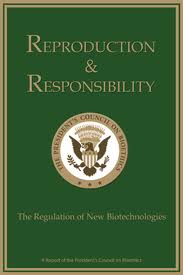The President's Council on Bioethics, Washington, DC, March 2004.
Excerpt:
This report differs from, yet complements, the Council’s work in its previous publications. In Human Cloning and Human Dignity, we addressed the limited topic of human cloning—what to think and what to do about it—and offered specific legislative recommendations. In Monitoring Stem Cell Research, we answered your request for an update on developments concerning human stem cell research, both in basic and clinical research and in the ethical and policy debates, as these have emerged under the current federal policy. In Beyond Therapy: Biotechnology and the Pursuit of Happiness, we surveyed growing capacities that biotechnologies are providing to serve non-medical goals—such as the desires for “better children,” “superior performance,” “ageless bodies,” and “happy souls”—and sought to raise public awareness of the challenges such pursuits might pose to the meaning of our humanity. And in Being Human, we offered a rich anthology of readings to help the nation better appreciate and promote those aspects of our humanity affected by the coming age of biotechnology. Only in this report do we address the large social and political question: how can we monitor, oversee, and regulate these burgeoning new technologies, so as to reap their benefits while avoiding their harms, both overt and subtle? How can we exercise responsible control over where biotechnology may be taking us, in order to both serve and preserve our humanity?
In investigating the general subject of the regulation of biotechnology, we have taken as our specific focus the intersection of the technologies of assisted reproduction, human genomic knowledge and technique, and human embryo research. Advances in biotechnology are providing new capacities for altering and influencing the beginnings of human life, especially life initiated outside the body, in the clinic, or in the laboratory. The well-established procedures of in vitro fertilization are being rapidly augmented by abilities to test the genetic make-up of embryos, to screen them for genetic diseases, to select them for their sex or (in the future) for some other desired traits, and to alter them in many other ways. These new capacities increase the variety and complexity of the options facing infertile couples and others seeking assisted reproduction, and they raise the prospect of changes in human reproduction that may have great significance not only for the parents and children involved, but also for society as a whole.
TABLE OF CONTENTS
Letter of Transmittal
Members of the President’s Council on Bioethics
Council Staff and Consultants
Preface
Acknowledgments
Executive Summary
Chapter One: Introduction
Chapter Two: Assisted Reproduction
Chapter Three: Screening and Selection for Genetic Conditions and Traits
Chapter Four: Modification of Traits and Characteristics
Chapter Five: Research Involving In Vitro Human Embryos
Chapter Six: Commerce
Chapter Seven: Diagnostic Survey: Summary and Conclusion
Chapter Eight: Findings
Chapter Nine: Policy Options
Chapter Ten: Recommendations
Appendix: Personal Statements
Online:
[pdf]
Amazon

